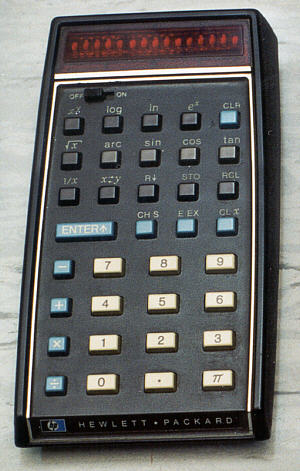HP 35

<<< *** >>> ^^^
| Manufacturer: | Hewlett Packard |
| Type: | 35 |
| Year: | 1972 |
| Technology: | ÁP PMOS |
| Price: | ca. DM 2000,- |
The HP 35 was the first calculator by Hewlett Packard. First, there was no type designation at all. The oldest designs are only labeled with "Hewlett Packard". Later on it was called HP 35, supposedly because of the number of the keys.
It was not the first calculator which could evaluate trigonometric and arithmetic functions. The handling was adaptet, with its reverse "polish notation" to the desktop calculators hp 9100 and hp 9810. However, it has only a one-line display, which shows the "Top of Stack". Instead it has 4 stack-layers and a extra memory.
Technically, it is based on five ICs from the Mostek company. These build up a bit-serial microprocessor with a word-length of 13 Bits: Three ROMs, one ALU with registerfile and a peripherial chip. On the beginning of the high-integrated circuits, bit-serial microprocessors were widespread. The ICs get along with few pins and memory is simply realised with shifting registers. Performance does not play an important role for a (desktop) calculator.
HP 35 Mainboard

... and we are inside
This was the text below the advertisement of the Mostek company in the 'Electronics' magazine. On the left page, Hewlett Packard advertised the HP 35, and on the right, Mostek advertised the IC kit inside the calculator. On the upper photo, only the three round ROMs come from Mostek, the others come from AMI.
By the way, what doesn't know anyone: The HP 35 didn't have 35 keys but 36. The 36th key is located under the ENTER-key, which is twice wide and is not accessible for the ordinary user. What happens when pressing it?
